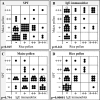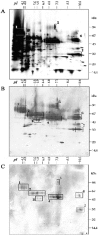High IgE sensitization to maize and rice pollen in the highlands of Madagascar
- PMID: 25870739
- PMCID: PMC4391898
- DOI: 10.11604/pamj.2014.19.284.4654
High IgE sensitization to maize and rice pollen in the highlands of Madagascar
Abstract
Introduction: Maize and rice are two crops constituting the main food supply in many under-developed and developing countries. Despite the large area devoted to the culture, the sensitization to the pollen from these plants is reported to be low and often considered as an occupational allergy.
Methods: Sixty five Malagasy pollen allergic patients were clinically and immunochemically investigated with regard to maize and rice pollen allergens. Pollen extracts were electrophoretically separated in 1 and 2 dimensions and IgE and IgG reactivities detected upon immunoblotting.
Results: When exploring the sensitization profile of Malagasy allergic patients to maize and rice pollen, it appears that a high proportion of these patients consulting during grass pollinating season were sensitized to both pollen as revealed by skin prick testing (62 vs. 59%) and IgE immunoblotting (85 vs. 40%). Several clinically relevant allergens were recognized by patients' serum IgE in maize and rice pollen extracts.
Conclusion: The high levels of maize and rice pollen sensitization should be related, in this tropical region, to a specific environmental exposure including i) a proximity of the population to the allergenic sources and ii) a putative exacerbating effect of a highly polluted urban atmosphere on pollen allergenicity. Cross-reactivities between wild and cultivated grasses and also between rice and maize pollen are involved as well as some specific maize sensitizations. The presence of dense urban and peri-urban agriculture, in various African regions and worldwide, could be a high environmental risk factor for people sensitive to maize pollen.
Keywords: IgE binding proteins; Madagascar; maize; pollen allergy; rice; urban and peri-urban agriculture.
Figures




Similar articles
-
Prevalence of sensitisation to oilseed rape and maize pollens in France: a multi-center study carried out by the Allergo-Vigilance Network.Eur Ann Allergy Clin Immunol. 2012 Dec;44(6):225-35. Eur Ann Allergy Clin Immunol. 2012. PMID: 23441440
-
Sensitization to Lolium multiflorum grass pollen in pollinosis patients: evaluation of allergenic fractions recognized by specific IgE antibodies.Int Arch Allergy Immunol. 2006;140(2):121-30. doi: 10.1159/000092531. Epub 2006 Apr 3. Int Arch Allergy Immunol. 2006. PMID: 16601349
-
Pollen Serum Specific IgE Sensitization in Respiratory Allergic Patients in Jakarta, Indonesia.Acta Med Indones. 2017 Jul;49(3):243-248. Acta Med Indones. 2017. PMID: 29093235
-
Enhanced diagnosis of pollen allergy using specific immunoglobulin E determination to detect major allergens and panallergens.J Investig Allergol Clin Immunol. 2011;21(4):253-9. J Investig Allergol Clin Immunol. 2011. PMID: 21721370
-
Allergenic potential of rice-pollen proteins: expression, immuno-cross reactivity and IgE-binding.J Biochem. 2013 Aug;154(2):195-205. doi: 10.1093/jb/mvt044. Epub 2013 May 20. J Biochem. 2013. PMID: 23694780 Clinical Trial.
Cited by
-
Allergic Anaphylactic Risk in Farming Activities: A Systematic Review.Int J Environ Res Public Health. 2020 Jul 8;17(14):4921. doi: 10.3390/ijerph17144921. Int J Environ Res Public Health. 2020. PMID: 32650469 Free PMC article.
References
-
- Aubry C, Ramamonjisoa J, Dabat M-H, Rakotoarisoa J, Rakotondraibe J, Rabeharisoa L. Urban agriculture and land use in cities: an approach with the multi-functionality and sustainability concepts in the case of Antananarivo (Madagascar) Land Use Pol. 2012;29(2):429–39.
-
- Aubry C, Ramamojisoa J, Dabat M-H, Rakotoarisoa J, Rakotondraibe J, Rabeharisoa L. Agriculture in Antananarivo (Madagascar): an interdisciplinary approach. Nat Sci Soc. 2008;16(1):169–89.
-
- Temple L, Moustier P. Functions and constraints of urban and periurban agriculture in three African cities (Yaoundé, Cotonou, Dakar) Agricultures. 2004;13(1):15–22.
-
- Beaujard P. The first migrants to Madagascar and their introduction of plants: linguistic and ethnologic evidence. Azania. 2011;46(2):169–89.
-
- Miracle MP. The introduction and spread of maize in Africa. J Afr Hist. 1965;6(1):39–5.
MeSH terms
Substances
LinkOut - more resources
Full Text Sources
Other Literature Sources
